Biohabitats Projects, Places, and People
By Amy Nelson
Shield Ranch Master Plan – Honor Award for Analysis and Planning
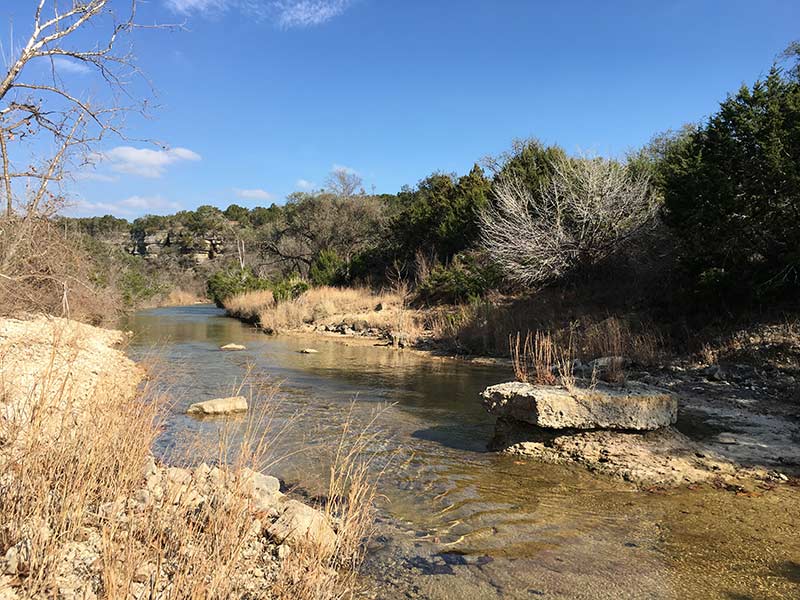 For 80 years, the 6,800-acre Shield Ranch in Travis County, Texas has been managed by a family with a strong land ethic and a commitment to conservation and stewardship. Examples of their efforts include placing 95% of the ranch under conservation easements and providing a nature immersion camp for urban kids who might not otherwise get to experience camp or the Hill Country landscape. As part of a team led by Andropogon Associates, we were honored to help the family and Ranch staff continue this legacy by working with them to develop a master plan to guide the realization of their future vision of a natural and cultural landscape that could be enjoyed by the family and shared with the public for generations to come.
For 80 years, the 6,800-acre Shield Ranch in Travis County, Texas has been managed by a family with a strong land ethic and a commitment to conservation and stewardship. Examples of their efforts include placing 95% of the ranch under conservation easements and providing a nature immersion camp for urban kids who might not otherwise get to experience camp or the Hill Country landscape. As part of a team led by Andropogon Associates, we were honored to help the family and Ranch staff continue this legacy by working with them to develop a master plan to guide the realization of their future vision of a natural and cultural landscape that could be enjoyed by the family and shared with the public for generations to come.
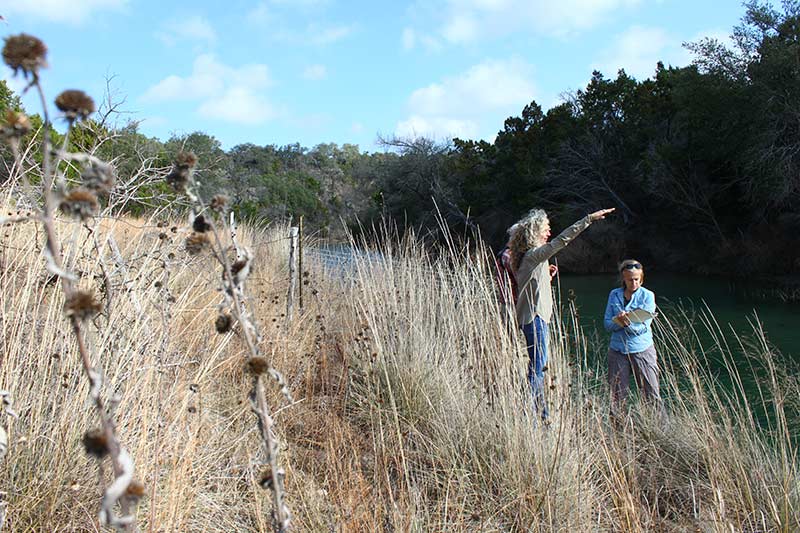 Of paramount importance was the awareness of the need to protect precious water resources, including Barton Creek, which crosses the property and is a critical resource for the nearby City of Austin. Our role included leading the effort to integrate water resource considerations through data collection and review of existing information; site inventory and analysis of opportunities and constraints for future ranch improvements; and collaborating on water management strategies. One of our key contributions was the development of hydrologic functional zones and a suitability analysis based on eco-hydrologic sensitivity to assist in siting of low impact development elements. We are grateful to have had the opportunity to work with this inspirational family and Andropogon’s team on this award-winning project. For more information about this project, contact Claudia Browne.
Of paramount importance was the awareness of the need to protect precious water resources, including Barton Creek, which crosses the property and is a critical resource for the nearby City of Austin. Our role included leading the effort to integrate water resource considerations through data collection and review of existing information; site inventory and analysis of opportunities and constraints for future ranch improvements; and collaborating on water management strategies. One of our key contributions was the development of hydrologic functional zones and a suitability analysis based on eco-hydrologic sensitivity to assist in siting of low impact development elements. We are grateful to have had the opportunity to work with this inspirational family and Andropogon’s team on this award-winning project. For more information about this project, contact Claudia Browne.
Floating Wetland at the National Aquarium Waterfront Campus – Honor Award for Research
In re-imagining its campus on two piers along Baltimore’s Inner Harbor a few years ago, the National Aquarium envisioned a living lab that enhances ecology and educates visitors about the unique habitats of the Chesapeake Bay. One such habitat is the tidal salt marsh, which has largely disappeared from the Inner Harbor’s post-industrial waterfront. As part of a team led by Ayers Saint Gross, we developed a suite of innovative technologies that provide habitat, restore ecological functions, and improve water quality in the canal between the campus’ two piers.
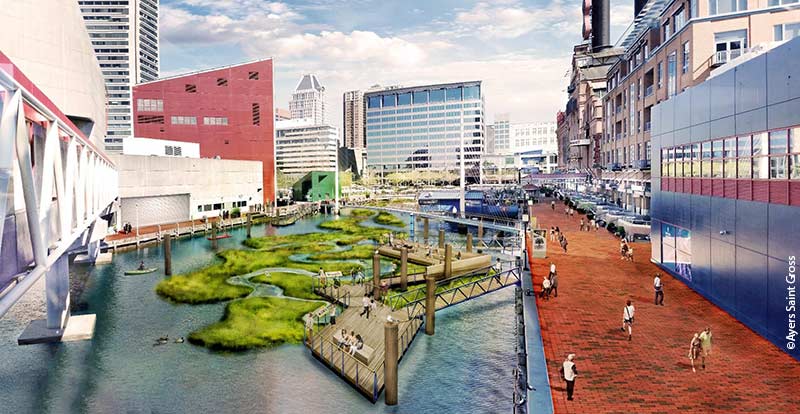
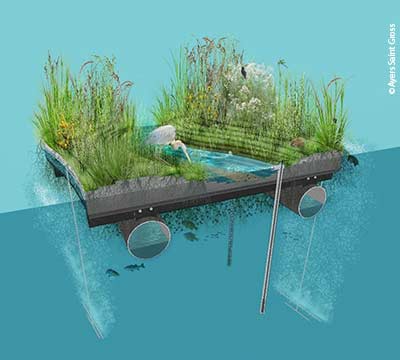 These technologies are now being piloted at the Aquarium’s doorstep. One of them, modeled after the tidal marsh, is a floating wetland. Planted with native marsh grasses, the floating wetland prototype incorporates novel advances such as adjustable buoyancy and integrated aeration to optimize its service life and habitat offerings. We’re thrilled to share the news that it won a 2018 Honor Award for Research from the American Society of Landscape Architects. Even more thrilling is the fact that the millions of people who visit the Aquarium each year can now see a tidal salt marsh along the Inner Harbor! For more information about this project, contact Chris Streb.
These technologies are now being piloted at the Aquarium’s doorstep. One of them, modeled after the tidal marsh, is a floating wetland. Planted with native marsh grasses, the floating wetland prototype incorporates novel advances such as adjustable buoyancy and integrated aeration to optimize its service life and habitat offerings. We’re thrilled to share the news that it won a 2018 Honor Award for Research from the American Society of Landscape Architects. Even more thrilling is the fact that the millions of people who visit the Aquarium each year can now see a tidal salt marsh along the Inner Harbor! For more information about this project, contact Chris Streb.
Speaking of Floating Wetlands…
When people describe Washington, DC’s District Wharf destination as vibrant, they’re not just talking about the restaurants, shops, entertainment venues, parks, trails, and piers along this one-mile stretch of the Potomac River. They’re also talking about what’s in the water. In addition to the boats, paddleboards, and kayakers visible from the piers and promenade, are four floating wetlands. Building on a concept developed by The Wharf’s landscape architect, Michael Vergason Landscape Architects, we collaborated with Clearwater Mills, LLC to design floating wetlands to be durable enough to withstand the conditions of the channel. Planted with native freshwater marsh plants and framed by a sleek, elliptically shaped, aluminum body, the wetlands pay homage to the natural system that once lined the Potomac River and the clean, modern aesthetic of The Wharf. The folks at The Wharf have reported lots of positive feedback about the wetlands from park users. After one year of growth, the plants seem to like the wetlands, too. They are well established and thriving!
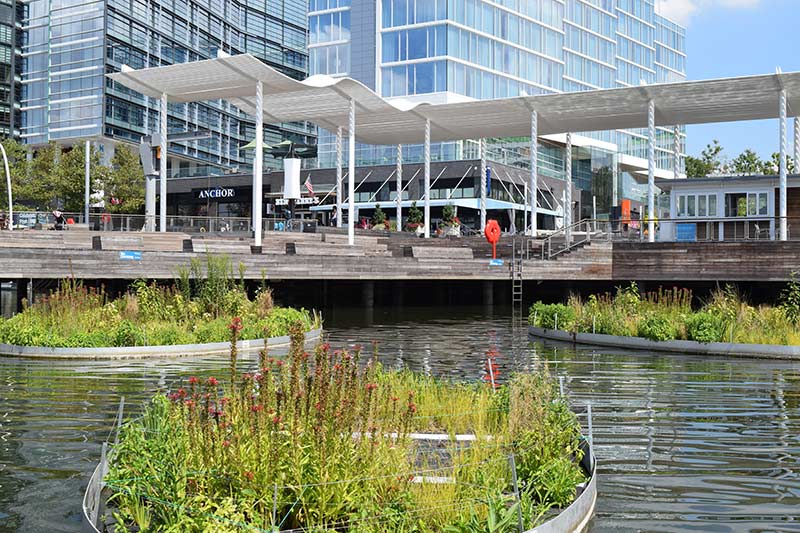
In 2016, we worked with Brown Advisory, an investment firm with offices located on a wharf that juts from the north shore of Baltimore Harbor, to install modular floating wetlands in the vacant canal next to the wharf. A key partner in the Waterfront Partnership of Baltimore’s Healthy Harbor Initiative–an effort to make Baltimore Harbor swimmable and fishable by 2020–Brown Advisory was eager to implement pilot projects to enhance waterfront ecology in their own backyard. We collaborated with Clearwater Mills, LLC to design the wetlands, and worked with volunteers from Brown Advisory to install native plants such as cordgrass (Spartina alterniflora), saltmeadow cordgrass (Spartina patens), saltgrass (Distichlis spicata), and saltmeadow rush (Juncus gerardii) in a media fabricated by Floating Wetland Solutions.
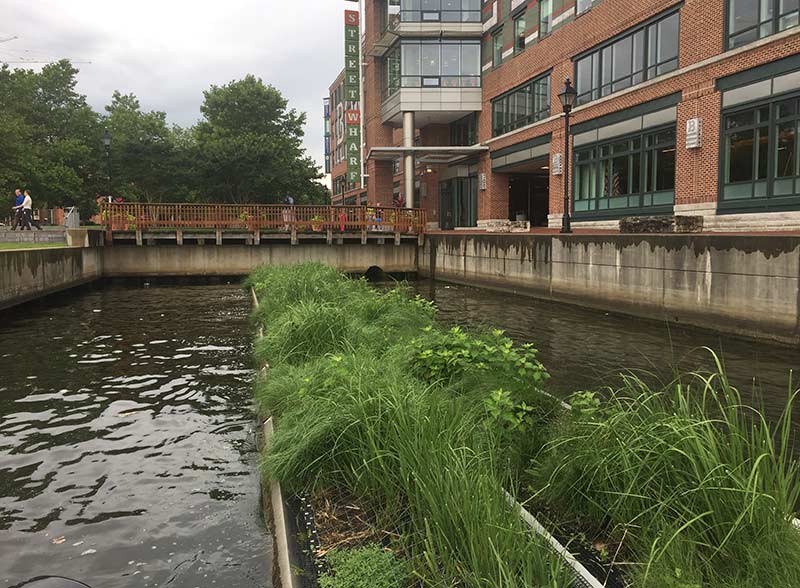
After two years of growth and some tethering upgrades to help them withstand the punishing wind and waves of heavy weather and boat traffic, the wetlands are doing wonderfully. They don’t just look like thriving wetlands, they sound like them. If you head down to Baltimore’s Bond Street Wharf on a quiet morning or evening, close your eyes, and listen to the humming buzz of insects that have inhabited the floating wetland, you can imagine the tidal marshes that once existed there. For more information about Biohabitats’ floating wetlands projects, contact Chris Streb.
Urban Forest Management Reduces Fire Risk
Ocean Breeze Park, which spans more than 110 acres on New York City’s Staten Island, was originally part of a vast tidal meadow through which a network of winding tidal creek channels traversed. Today, it is the site of a state-of-the-art track and field complex, which is surrounded by a natural landscape of native uplands, including forests and grasslands, and freshwater wetlands. In addition to providing important wetland and upland habitat, these natural habitats help cool temperatures, improve air and water quality, and enhance coastal resilience in this ultra-urban environment. However, the Park’s natural habitats have become vulnerable. Parts of the park are dominated by common reed (Phragmites australis), the main fuel source for fires along the south shore of Staten Island. To make matters worse, these habitat’s ability to naturally thrive is under threat from invasive species, dumping, and storm damage.
Fortunately, NYC Parks is taking action to simultaneously reduce fire risk and enhance ecological health and resiliency.
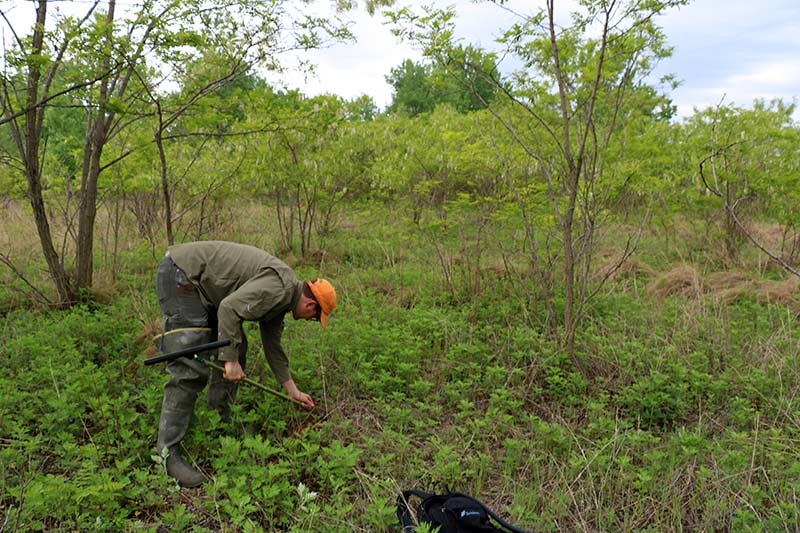
As a pilot project funded through a U.S. Forest Service grant to implement a Community Wildfire Protection Plan (CWPP) to reduce hazardous fuel loads, NYC Parks is leading an effort to manage common reed and other non-native invasive species and convert the Park from moderate to high risk fire zones into managed native species communities. This project seeks to carefully remove non-native plant species in both uplands and wetland areas through selective mechanical and chemical methods. Other targets for removal in the upland area include mugwort (Artemesia vulgaris) and invasive vines (Ampelopsis & Celastrus sp.), which add to hazardous fuel loads and provide a physical ladder for the vertical spread of fire from forest floor and adjacent common reed, increasing the risk for crown fires that can damage or destroy the existing native forest canopy. After invasive species have been effectively managed, the site will then be planted with native trees, shrubs, and herbaceous species to help keep invasive species from recolonizing the site. We recently helped NYC complete an important first step in this project by conducting a wetland delineation. While we always enjoy the opportunity to muck about in wetlands, the knowledge that this work will ultimately improve the safety and resiliency of Ocean Breeze Park made this delineation project even more rewarding. For more information about this project, please contact Terry Doss.
Logging in ecological improvements to a State Scenic River near Cleveland
Despite the fact that the Chagrin River borders the highly urbanized Cleveland metropolitan region, it boasts such high-quality riparian conditions, water quality, habitat, and beauty that it has been designated a State Scenic River. The River is not only enjoyed and treasured by the communities surrounding it, it is cared for by them. When a reach flowing through the Village of Hunting Valley became degraded and severely eroded following upstream dam removals and years of development in the watershed, the community took action. With funding from the Ohio EPA, and strong partnerships with the Chagrin River Watershed Partners, the Western Land Conservancy, and private landowners, the Village initiated a restoration project. Teaming with Meadville Land Service, we jumped at the chance to help the Village restore beauty, accessibility, and ecological function to the degraded reach. After all, the Chagrin River is not only a treasured State Scenic River in a highly urban environment, but a direct tributary to Lake Erie.
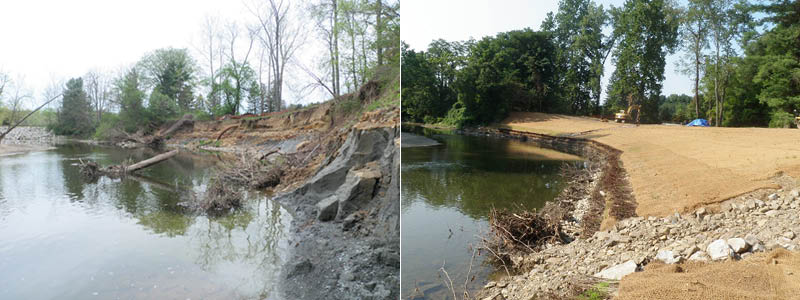
Using on-site material and alternatives to rock wherever possible, the restoration involved the installation of a large, engineered log complex (think REALLY large version of pick-up-sticks meets Jenga) to stabilize the toe of bank, slow near bank velocities, direct flow away from the bank, and add the kinds of underwater nooks and crannies that fish and aquatic insects love. This was the first stream restoration project in northeast Ohio to use a large-scale engineered log complex, and so far, it is demonstrating a promising alternative to traditional rip-rap and rock stabilization. For more information about this project, contact Tom Denbow.
Building a Stronger City with Baltimore’s Green Network
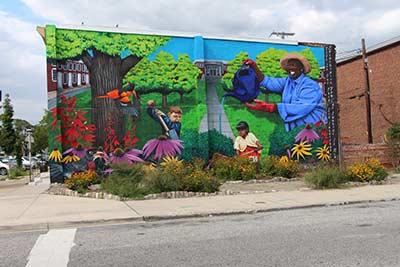 Baltimore, Maryland boasts an extensive waterfront, numerous parks, three major stream corridors, four nature centers, and more than 2.6 million trees. Yet many of these resources lack connectivity–to each other and to many city residents. At the same time, many of Baltimore’s neighborhoods are blighted by abandoned properties, vacant lots, and economic and access disparities that span generations. In 2016, the city’s Department of Planning and Office of Sustainability recognized an opportunity to link these issues in an effort to improve the quality of life in Baltimore. They initiated the development of the Baltimore Green Network Plan, a strategy to revitalize communities, transform vacant lots, and create a city-wide, interconnected system of green space. For the past two years, we have been honored to join the City in leading a multi-disciplinary team charged with crafting that plan. We began by analyzing and prioritizing vacant sites most appropriate for inclusion in the Baltimore Green Network and sharing this information with community members in a series of public meetings. We then helped the City conduct several design charrettes in focus area neighborhoods to learn more about their needs and seek community input in developing concepts for greening strategies. What emerged was an envisioned network of “nodes” and “corridors.” The nodes, or hubs, are destinations that provide opportunities for recreation, social gatherings, improved habitat, and/or economic revitalization. Corridors provide connections between the nodes, and come in the form of streams, streets, or trails to provide safe and comfortable routes that link neighborhoods and connect green spaces throughout the city. Now finalized, the Baltimore Green Network includes new recreation areas, expanded habitat along the city’s defining stream corridors, pocket parks with native wildflower gardens, and integrated stormwater management techniques along bike-friendly streets. The development of the Green Network Plan was a truly collaborative undertaking. Throughout the planning process, the team, which included Floura Teeter Landscape Architects, Toole Design Group, Advanced Placemaking, and Living Design Lab, engaged and gathered input from citizens, an Agency Work Group, an Advisory Team, and a Leadership Team. Next week, the Baltimore City Planning Commission will vote to adopt the plan on September 27, and we can’t wait to see it come to life. For more information about this project, contact Jennifer Dowdell.
Baltimore, Maryland boasts an extensive waterfront, numerous parks, three major stream corridors, four nature centers, and more than 2.6 million trees. Yet many of these resources lack connectivity–to each other and to many city residents. At the same time, many of Baltimore’s neighborhoods are blighted by abandoned properties, vacant lots, and economic and access disparities that span generations. In 2016, the city’s Department of Planning and Office of Sustainability recognized an opportunity to link these issues in an effort to improve the quality of life in Baltimore. They initiated the development of the Baltimore Green Network Plan, a strategy to revitalize communities, transform vacant lots, and create a city-wide, interconnected system of green space. For the past two years, we have been honored to join the City in leading a multi-disciplinary team charged with crafting that plan. We began by analyzing and prioritizing vacant sites most appropriate for inclusion in the Baltimore Green Network and sharing this information with community members in a series of public meetings. We then helped the City conduct several design charrettes in focus area neighborhoods to learn more about their needs and seek community input in developing concepts for greening strategies. What emerged was an envisioned network of “nodes” and “corridors.” The nodes, or hubs, are destinations that provide opportunities for recreation, social gatherings, improved habitat, and/or economic revitalization. Corridors provide connections between the nodes, and come in the form of streams, streets, or trails to provide safe and comfortable routes that link neighborhoods and connect green spaces throughout the city. Now finalized, the Baltimore Green Network includes new recreation areas, expanded habitat along the city’s defining stream corridors, pocket parks with native wildflower gardens, and integrated stormwater management techniques along bike-friendly streets. The development of the Green Network Plan was a truly collaborative undertaking. Throughout the planning process, the team, which included Floura Teeter Landscape Architects, Toole Design Group, Advanced Placemaking, and Living Design Lab, engaged and gathered input from citizens, an Agency Work Group, an Advisory Team, and a Leadership Team. Next week, the Baltimore City Planning Commission will vote to adopt the plan on September 27, and we can’t wait to see it come to life. For more information about this project, contact Jennifer Dowdell.
Sometimes Being Inundated is a Good Thing
Located at the mouth of the Columbia River, and offering over 500 acres of intertidal and upland habitat, Oregon’s West Sand Island is a crucial location for migrating fish. The island’s connection to the tidal range has been limited by human impacts, including the presence of a berm along the north and east sides of the island. Providing better tidal access to targeted portions of the island will offer ecological benefits, including habitat for 13 threatened and endangered salmon and steelhead species. The island’s wetland and upland habitats are further degraded by invasive species, such as gorse (Ulex europaeus) and Scotch Broom (Cytisus scoparius). Fortunately, the island has a committed steward in the Columbia River Estuary Task Force (CREST). For the last year, we have had the pleasure of working with CREST to refine design approaches intended to maximize fish and wildlife wetland habitat capacity through the increased frequency, duration, and magnitude of inundation.
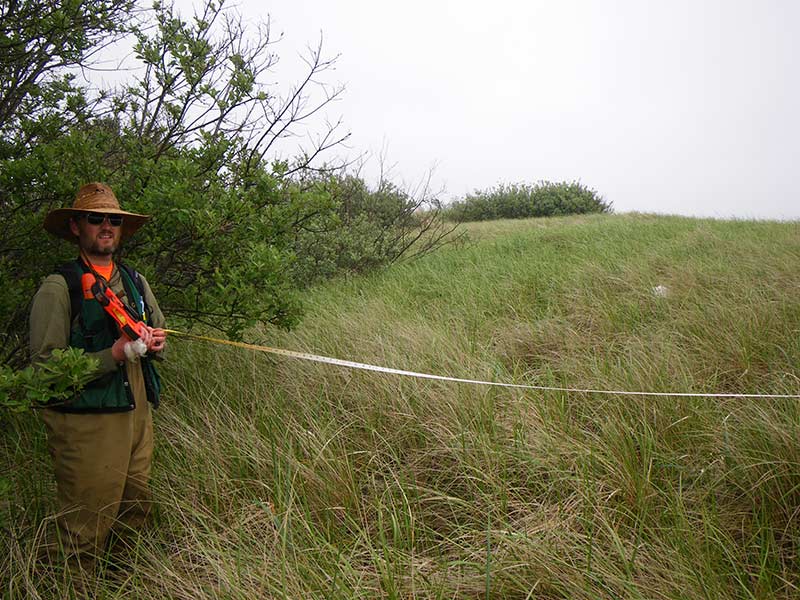
The design will also enhance and manage native vegetation communities consistent with the proposed hydrologic regime, including protecting existing costal grassland/prairie vegetation communities. The approach involves breaching portions of the berm and excavation of tidal connections to target low spots on the island’s interior. It also involves the treatment of more than 70 acres of invasive species. The project is slated for construction next year, and we can’t wait to see the tidewaters Columbia River reconnect with the interior of the beautiful West Sand Island. For more information about this project, contact Pete Muñoz.
Georgia Tech Eco-commons
Georgia Tech is serious about urban ecology. With a canopy of nearly 12,000 trees–and approximately 130 species-the Georgia Tech campus is a proving ground for demonstrating how an ecologically robust campus environment can serve to not only contribute to a lush campus atmosphere for its students, faculty, administrators and visitors, but can also work to conserve water, reduce heat island effects, sequester carbon, and enhance biodiversity. The backbone of this landscape is the Georgia Tech Eco-commons, a ribbon of outdoor spaces intricately woven throughout the campus. We are excited to announce that Barge Solutions, with Nelson Byrd Woltz, Biohabitats, and Long Engineering, was recently selected to design a major component of the Eco-commons. Our approach will be to explore how the Eco-commons could serve as a catalyst to facilitate, enhance, maximize, and perpetuate ecological processes and functions throughout the campus and beyond. We will look to better understand how the Eco-commons can serve as patches, corridors, stepping stones, edges, and matrix habitat for species at multiple nested scales. We will focus on water and nutrients flows, exchanges and pulses while meeting Georgia Techs progressive stormwater management goals. We will develop an adaptive management framework that addresses operations and maintenance needs within an evolving living system. We’ll also be searching for ways to embed academic research projects, outdoor learning opportunities, technology and citizen science to create continuous learning experiences for future generations of students. For more information about this project, contact Keith Bowers.
Ecology Takes No Summer Break at This Baltimore City School
In the last issue of Leaf Litter, just as the school year was ending, we told you about our work with Blue Water Baltimore and Green Street Academy (GSA), a Baltimore City public charter school for middle and high schoolers, to improve stormwater management and ecology on the school’s property. At that time, the project team had just finished working with GSA students, faculty, and staff, and volunteers from the National Wildlife Federation and the Conservation Corps to plant and mulch a new, 6,000 square foot pollinator meadow.
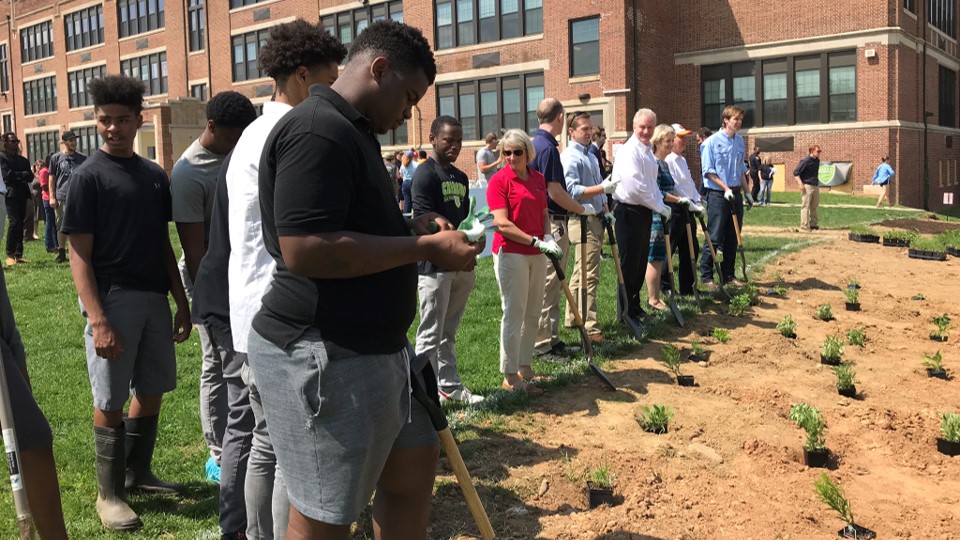
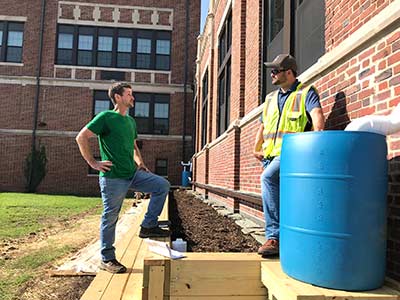
By the time students returned to school earlier this month, the meadow was in full bloom, with butterfly weed, purple coneflower, black-eyed Susan, and blazing star already attracting a variety of birds and insects. Even more happened while students were away this summer. We worked with Blue Water Baltimore to build and install a raised rain garden planter, which is irrigated with rainwater from the roof and features comfortable seating, and micro-bioretention areas that capture and filter stormwater from the faculty parking lot. Native plants were used in both new features, adding even more habitat for pollinators and other wildlife. In addition to enhancing ecology and stormwater management on the GSA campus, these projects provide unique outdoor learning spaces where students can see, touch, smell, and hear subjects they could previously only read about in text books. GSA wants their students to be prepared for a world that is rapidly adapting to and relying upon technology and practices related to sustainability. We’re thrilled to have worked with them to create examples of such practices right in their own backyard! For more information about our work at Green Street Academy, contact Jim Cooper.
Places
Cities Alive, North America’s leading forum to discuss benefits and strategies of green roof and wall design, installation, and maintenance, will take place in New York City September 24-26. Biohabitats Senior Landscape Architect/Ecological Planner David Yocca will facilitate a workshop on the Living Architecture Performance Tool, a rating system intended to certify that green roofs and walls are designed to achieve certain measurable and replicable performance benefits, so that they can be funded, designed, installed, and maintained with a high degree of confidence.
Next week, from Sept. 25-28, the Colorado Association of Stormwater and Floodplain Managers will hold its annual conference in Snowmass, CO. Biohabitats ecological engineer, Mike Lighthiser, will be there. Will you?
 Earlier this year, we announced the news that Biohabitats had become a Certified B Corporation. Issued by the nonprofit B Lab®, B Corp certification is earned by companies that meet rigorous standards of social and environmental performance. We’re proud to have joined a growing B Corp community of more than 2,200 corporations in over 50 countries, and we plan to celebrate with some of those in the Mid-Atlantic region on October 2, when we’ll join BMore Mid-Atlantic and Gila Press in co-hosting a happy hour themed around the Baltimore food scene. Learn more!
Earlier this year, we announced the news that Biohabitats had become a Certified B Corporation. Issued by the nonprofit B Lab®, B Corp certification is earned by companies that meet rigorous standards of social and environmental performance. We’re proud to have joined a growing B Corp community of more than 2,200 corporations in over 50 countries, and we plan to celebrate with some of those in the Mid-Atlantic region on October 2, when we’ll join BMore Mid-Atlantic and Gila Press in co-hosting a happy hour themed around the Baltimore food scene. Learn more!
Want to stretch your legs for a great cause? Come join us on Oct. 6 for the Riverfront North Partnership’s Greenway 5K. We’re proud to sponsor a beautiful run along the Delaware River in Philadelphia. Proceeds will support maintenance and community events so that people and wildlife can continue to enjoy the parks and trails of Riverfront North.
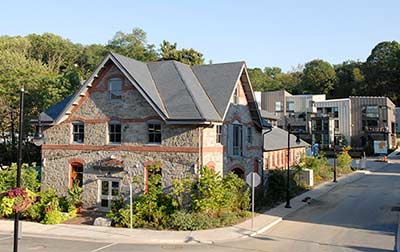
What does Biohabitats Chesapeake/Delaware Bays Bioregion office have in common with a jewelry center, a war memorial, and a brewing company? We’re all among the buildings you can visit during Doors Open Baltimore on October 6. Hosted by the Baltimore Architecture Foundation, in partnership with AIA Baltimore, this free, citywide celebration of Baltimore’s architecture and neighborhoods allows you to explore more than 60 buildings across the city.
On October 8, Biohabitats senior ecologist Joe Berg will address attendees at the Mid-Atlantic chapter of the Society for Arboriculture’s annual meeting in Frederick, MD with a talk on the use of trees and vegetation in stream restoration and other uses of tree “waste.”
Biohabitats Hudson River Bioregion leader, Terry Doss, will be joining supporters of NY/NJ Baykeeper in honoring former Baykeeper Debbie Mans and the organization’s annual awards dinner on Oct. 11 at the Monmouth Boat Club.
Ecological engineer Mike Lighthiser from our Southern Rocky Mountain Bioregion office will attend the American Society of Civil Engineers’ National Convention in Denver Oct. 12-14.
Blue Water Baltimore works tirelessly to restore the quality of Baltimore’s rivers, streams and Harbor, and strengthen the city’s environment, economy and communities. We’re honored to support them by sponsoring their annual Blue Water Bash on October 15. Join the fun at BoatHouse Canton on the Baltimore waterfront.
The North American Chapter of the Society for Ecological Restoration is teaming up with the Pacific Northwest Chapter of the Society of Wetland Scientists to host “Restoring Resilient Communities in Changing Landscapes” October 15-18 in Spokane, WA. Senior ecologist Joe Berg will be among the scientists, practitioners, and decision makers gathering to discuss this important topic.
This year’s EcoDistricts Summit will take place in Minneapolis-St. Paul Oct. 17-18. Now in its ninth year, the Summit draws leading city makers, policy makers, developers, designers, financiers, and community leaders from North America and beyond to collaborate, explore, and inspire the next generation of neighborhood development with a focus on equity, resilience, and climate action.
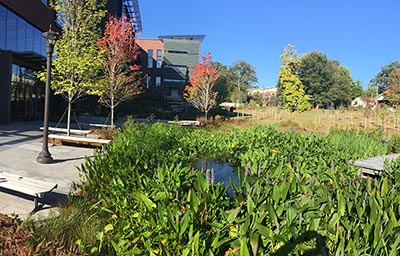
On Oct. 18, the International Living Future Institute will present Net Positive Atlanta: Subtropical Solutions, an inspiring event that will focus on the success stories of pioneering Living Building Challenge project teams as they pursue the world’s most rigorous green building standard in Atlanta’s hot and humid climate. Biohabitats senior engineer, Erin English is one of the event’s featured speakers. She will present “Net Positive Water: Policy + Practice in the Humid Southeast.”
The Annual Meeting of the American Society of Landscape Architects will take place in Philadelphia, PA Oct. 19-22. The first day of the conference will be a busy one for Biohabitats attendees. David Yocca and Jennifer Dowdell of Biohabitats will join Herbert Dreiseitl of the Ramboll Group in presenting “Ecocities of the Future…Today: Addressing Economic and Ecological Imperatives.” Panelists Erin English and Crystal Grinnell of Biohabitats will discuss “Resilient Water Strategies: The Future of On-site Wastewater Treatment and Reuse.” Justin Park will be part of a large panel discussion of “Reinventing the River: Central and North Delaware Waterfronts.” Ecological Engineer Chris Streb will join landscape architect Jonathan Ceci and the National Aquarium’s Jaqueline Bershad in presenting “Where Land Meets Water: Rethinking the Shoreline in Urban Waterfronts.” On Oct. 22, senior ecologist Joe Berg will be joined by Stephen Handel of Harvard University’s Graduate School of Design and Nancy Owens of Nancy Owens Studio on a panel discussion of “Collaborative Restoration: Integrating Landscape Architecture and Ecology for Resilient Landscape Design.” The panel will be moderated by Ann Kearsley of Ann Kearsley Design.
We’re proud to be a Gold sponsor of the Mid-Atlantic Council of Trout Unlimited’s 2nd Annual 2-FLY Tournament on the Savage River September 22.
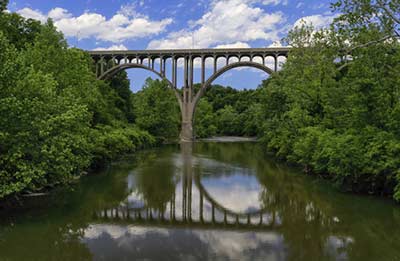
We are proud to sponsor the Baltimore Ecosystem Study’s Annual Research Conference on Oct. 23-25 in Baltimore, MD, and we look forward to hearing updates on long-term ecological research being conducted in the city.
We’re proud to sponsor this year’s Cuyahoga River Area of Concern Symposium on October 26 in Cuyahoga Falls, OH. If you plan to attend, be sure to stop by the Biohabitats table and say hello to our Great Lakes Bioregion leader Tom Denbow.
The 53rd Annual Conference of the American Water Resources Association will take place in Baltimore Nov. 4-8. On November 6, Ted Brown will moderate a session “Cutting Through the Tape – How NGOs are Leading the Way with Chesapeake Bay Restoration,” which will feature panelists from the South River Federation, Blue Water Baltimore, and Chesapeake Rivers.
One of the most prominent barriers to net positive water is the lack of information surrounding the costs, benefits, and financial motivators for innovative water systems. How much do these systems cost to install and operate? How do they impact the cost of utilities? On Nov. 14, at the 2018 Greenbuild International Conference & Expo in Chicago, these and other questions will be answered in “Direct from the Source: The Costs & Benefits of Net Positive Water,” a presentation by Biohabitats senior engineer Pete Munoz, Kathleen Smith of the Living Future Institute, Chris Gorri of the Chesapeake Bay Foundation, and Skip Backus of the Omega Institute. On Nov. 16, Biohabitats senior landscape architect/ecological planner, David Yocca, will join Barbara Deutsch from the Landscape Architecture Foundation to present Designing for Landscape Performance: Insights and Examples from Practice, a program that will explore the concept of landscape performance and why it is critical to achieving sustainability and reaching key decision-makers.
On Dec. 7, Senior environmental scientists Sarah Roberts and Mike Thompson will heat to Linthicum, MD for the Maryland Water Quality Monitoring Council’s 24th Annual Conference. The theme of this year’s event is “Science, Stewardship, and Citizen Involvement – Working Together for Clean Water.”
People
Meet Environmental Scientist, Lauren Anderson
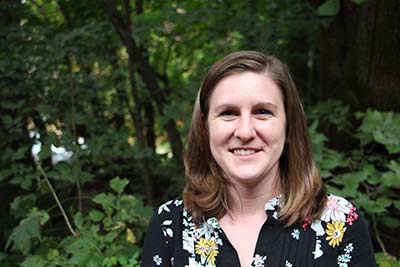
Favorite ecosystem: I grew up on Maryland’s Bush River, so I developed a fondness for anything aquatic.
Expertise: Environmental construction
Favorite type of project: I love overseeing Biohabitats’ active construction projects but I get especially excited when I am asked to help with the constructability of a plan set.
Best Biohabitats moment so far: I am coming up on closing out the oversight of my first Biohabitats construction project. First one down, many more to go!
Hobbies: I love to hang out with my family and friends, whether that be packing up the camper for a race weekend with the significant other and our dog, kayaking down a local waterway with family, or grabbing some great local eats & drinks with friends.
Surprising talent: I was part of a jump rope team from kindergarten to middle school.
Role model: My parents and grandparents. Hard working, middle class Americans who taught me the importance of a good work ethic to get what you want in life.
Volunteer work: I love participating in any Harford Land Trust event! Their vital role is to conserve land, protect its natural resources, scenic beauty, rural character, and promote a healthy quality of life in Harford County, MD.
Kindergarten career aspiration: I loved horses growing up and so I wanted to be a Jockey. I was super tiny, so it seemed feasible
Certifiably Awesome!
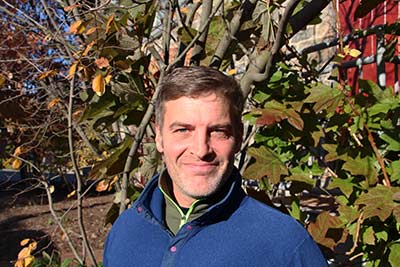
Senior Environmental Scientist, Bryon Salladin, recently achieved the Certified Forester accreditation from the Society of American Foresters (SAF). SAF is the largest national scientific and educational organization representing the forestry profession in the United States. SAF’s Certified Forester (CF) program is the most established forester credentialing program in the world and is the gold standard for forest management professionals. Certified Forester is the highest level of certification offered by SAF. Kudos, Bryon!
Golden Acorn Winner
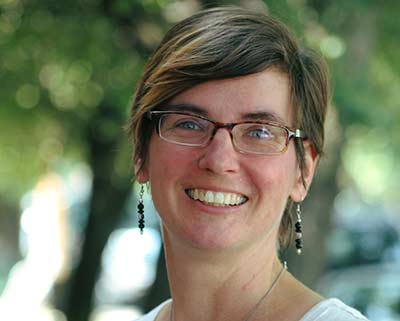
Every quarter, Biohabitats awards one staff member with the Golden Acorn, an award recognizing an employee who embodies the Biohabitats mission to “Restore the Earth and Inspire Ecological Stewardship.” The gold color symbolizes purity of purpose in protecting and defending nature, and the acorn symbolizes strength of resolve. Nominees are submitted by the staff. Our most recent Golden Acorn winner was environmental engineer, Suzanne Hoehne. Recipients of the Golden Acorn get to direct a monetary donation to the non-profit organization of their choice. Suzanne split her donation to support two causes very close to her heart and home. Half of Suzanne’s donation went to the Beargrass Creek Alliance’s Every Drop program, which helps homeowners (and renters with landlord consent) in Kentucky’s Beargrass Creek watershed install Best Management Practices on their properties. The other half went to help victims of last month’s historic flood in Mazomanie, WI, where Suzanne attended high school.
